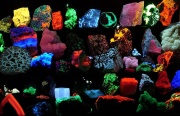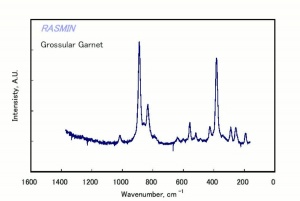Fluorescent minerals
Description
Minerals that have the unique physical property to absorb light and one wavelength and instantaneously release it at a different wavelength, resulting in a temporary color change to the eye of the human observer. Only about 15% of minerals are able to fluoresce. The fluorescence is usually due to a cation activator, such as: tungsten, molybdenum, lead, boron, titanium, manganese, uranium, and chromium, but some rare earth elements are also able to contribute to the phenomenon. Some trace elements, such as iron or copper, can quench the fluorscence. Most minerals fluoresce a single color, but some may have multiple colors; for example calcite can fluoresce red, blue, white, pink, green and orange. Because of the potential for many varying factors, the fluorescence of mineral is not typically used for its identification.
Other Properties
| Mineral | Composition | Visible color | Fluorescent color |
|---|---|---|---|
| Apatite | Ca5(PO4)3(F,Cl,OH) | pale green to purple | pink, blue, greenish yellow |
| Calcite | CaCO3 | colorless to white | red, blue, pink, green, orange |
| Cerrusite | PbCO3 | colorless to white | yellowish |
| Chalcedony | SiO2 | white, blue, pink | variable |
| Corundum | Al2O3 | red (ruby), blue (sapphire) | red (ruby), none (sapphire) |
| Fluorite | CaF2 | colorless to white | blue-violet |
| Quartz | SiO2 | colorless, purple | variable |
| Rhyolite | PbCO3 | colorless to white | yellowish |
| Sphalerite | (Zn,Fe)S | yellow, brown, gray, black | lighter specimens = yellowish |
| Willemite | Zn2SiO4 | colorless, white, gray, red, brown | strong white |
Additional Information
J. Ogden, Jewelry of the Ancient World, Rizzoli International Publications, New York, 1982.
Comparisons
Properties of Common Abrasives
Properties of Common Gemstones
Natural and Simulated Diamonds

